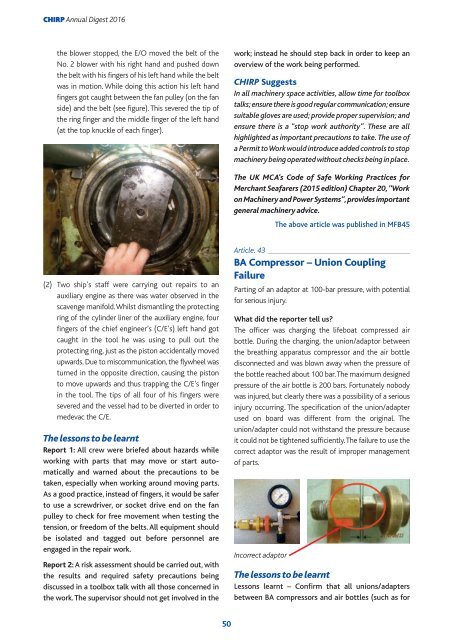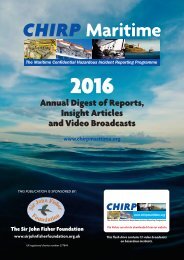CHIRP annual digest 2016 6th
Create successful ePaper yourself
Turn your PDF publications into a flip-book with our unique Google optimized e-Paper software.
<strong>CHIRP</strong> Annual Digest <strong>2016</strong><br />
the blower stopped, the E/O moved the belt of the<br />
No. 2 blower with his right hand and pushed down<br />
the belt with his fingers of his left hand while the belt<br />
was in motion. While doing this action his left hand<br />
fingers got caught between the fan pulley (on the fan<br />
side) and the belt (see figure). This severed the tip of<br />
the ring finger and the middle finger of the left hand<br />
(at the top knuckle of each finger).<br />
work; instead he should step back in order to keep an<br />
overview of the work being performed.<br />
<strong>CHIRP</strong> Suggests<br />
In all machinery space activities, allow time for toolbox<br />
talks; ensure there is good regular communication; ensure<br />
suitable gloves are used; provide proper supervision; and<br />
ensure there is a “stop work authority”. These are all<br />
highlighted as important precautions to take. The use of<br />
a Permit to Work would introduce added controls to stop<br />
machinery being operated without checks being in place.<br />
The UK MCA’s Code of Safe Working Practices for<br />
Merchant Seafarers (2015 edition) Chapter 20, “Work<br />
on Machinery and Power Systems”, provides important<br />
general machinery advice.<br />
The above article was published in MFB45<br />
(2) Two ship’s staff were carrying out repairs to an<br />
auxiliary engine as there was water observed in the<br />
scavenge manifold. Whilst dismantling the protecting<br />
ring of the cylinder liner of the auxiliary engine, four<br />
fingers of the chief engineer’s (C/E’s) left hand got<br />
caught in the tool he was using to pull out the<br />
protecting ring, just as the piston accidentally moved<br />
upwards. Due to miscommunication, the flywheel was<br />
turned in the opposite direction, causing the piston<br />
to move upwards and thus trapping the C/E’s finger<br />
in the tool. The tips of all four of his fingers were<br />
severed and the vessel had to be diverted in order to<br />
medevac the C/E.<br />
The lessons to be learnt<br />
Report 1: All crew were briefed about hazards while<br />
working with parts that may move or start auto -<br />
matically and warned about the precautions to be<br />
taken, especially when working around moving parts.<br />
As a good practice, instead of fingers, it would be safer<br />
to use a screwdriver, or socket drive end on the fan<br />
pulley to check for free movement when testing the<br />
tension, or freedom of the belts. All equipment should<br />
be isolated and tagged out before personnel are<br />
engaged in the repair work.<br />
Report 2: A risk assessment should be carried out, with<br />
the results and required safety precautions being<br />
discussed in a toolbox talk with all those concerned in<br />
the work. The supervisor should not get involved in the<br />
Article. 43<br />
BA Compressor – Union Coupling<br />
Failure<br />
Parting of an adaptor at 100-bar pressure, with potential<br />
for serious injury.<br />
What did the reporter tell us?<br />
The officer was charging the lifeboat compressed air<br />
bottle. During the charging, the union/adaptor between<br />
the breathing apparatus compressor and the air bottle<br />
disconnected and was blown away when the pressure of<br />
the bottle reached about 100 bar. The maximum designed<br />
pressure of the air bottle is 200 bars. Fortunately nobody<br />
was injured, but clearly there was a possibility of a serious<br />
injury occurring. The specification of the union/adapter<br />
used on board was different from the original. The<br />
union/adapter could not withstand the pressure because<br />
it could not be tightened sufficiently. The failure to use the<br />
correct adaptor was the result of improper management<br />
of parts.<br />
Incorrect adaptor<br />
The lessons to be learnt<br />
Lessons learnt – Confirm that all unions/adapters<br />
between BA compressors and air bottles (such as for<br />
50



